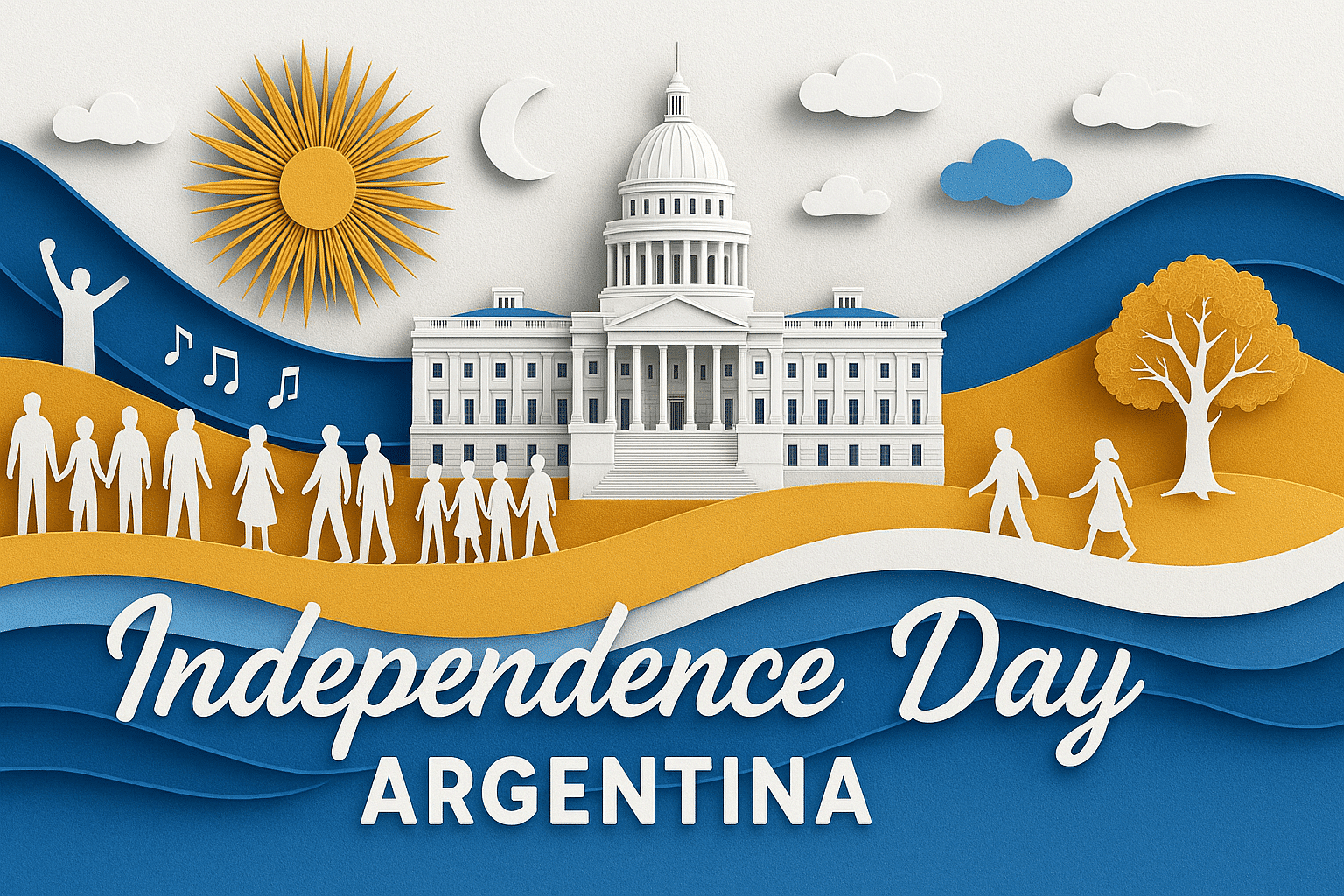What is Independence Day (Argentina)?
Independence Day in Argentina is celebrated annually on July 9 and commemorates the nation’s declaration of independence from Spanish rule. This historic event, which took place in 1816, marked a significant moment in the formation of Argentina as an independent nation. The day honors the bravery and determination of the Argentine people, who, after years of struggle and revolution, broke free from colonial rule. It is one of the most important national holidays in Argentina, celebrated with pride and reflection across the country.
The declaration of independence occurred in the city of San Miguel de Tucumán, where representatives from the United Provinces of the Río de la Plata met in what is now called the House of Tucumán. On this day, they proclaimed Argentina’s freedom, paving the way for the establishment of a new sovereign state.
History and Origin
Independence Day traces its origins to the Congress of Tucumán, which convened in March 1816. Delegates from various provinces of the former Viceroyalty of the Río de la Plata met to discuss their future as a nation. For years, the region had been engaged in a struggle for autonomy, beginning with the May Revolution of 1810, which led to the establishment of a local government in Buenos Aires.
The Congress debated the country’s future, and on July 9, 1816, after intense discussions, the declaration was made. Narciso Laprida, the president of the Congress, formally asked if the provinces wished to become an independent nation. The unanimous response was yes. The declaration asserted that the provinces were no longer under the rule of Spain, and it also rejected any further domination by foreign powers, including Portugal.
The Act of Independence was signed on that day, solidifying the break with Spain and stating the formation of a free and independent nation. This document also renounced allegiance to any monarch, asserting Argentina’s position as a sovereign republic. This momentous declaration, which marked the birth of modern Argentina, remains a pivotal moment in the nation’s history.
Who participates in Independence Day (Argentina)?
- Argentine citizens: Participate in national celebrations, parades, and ceremonies throughout the country.
- Government institutions: Organize official ceremonies at the House of Tucumán and other significant locations, including Plaza de Mayo in Buenos Aires.
- Educational institutions: Host activities and lessons to teach students about Argentina’s struggle for independence and the significance of the day.
- Cultural and social organizations: Organize concerts, folkloric dances, and artistic exhibitions that reflect Argentine heritage.
- Families: Gather together for traditional meals, such as asado, locro, and empanadas, to celebrate the holiday.
Slogans and Themes
Independence Day is marked by a sense of pride, unity, and patriotism. Common themes for this day focus on Argentina’s historical roots, its fight for liberty, and the unity of its people. Slogans like “Viva la Patria” (Long live the nation) and “Unidad, Libertad y Justicia” (Unity, Freedom, and Justice) are often heard, reflecting the foundational values of the Argentine Republic. The day emphasizes the importance of national unity and the ongoing commitment to the ideals of independence.
Colors, Symbols, and Patterns
Colors
- Light blue and white: These colors represent the Argentine flag, symbolizing the sky and peace.
- Red: A color that represents the bravery and courage of the revolutionaries.
- Gold: Represents the richness and cultural significance of the nation.
Symbols
- The Argentine Flag: Raised proudly across the nation, symbolizing Argentina’s independence and sovereignty.
- The National Shield: Represents the unity of the provinces and the ideals of independence.
- The House of Tucumán: The historic location where the Act of Independence was signed, symbolizing the country’s freedom.
Patterns
- Horizontal stripes: Representing the flag, often used in decorations and clothing.
- Stars: Symbolizing the provinces of Argentina and their union.
- Sun motifs: Associated with the Sun of May, a symbol of independence and the nation’s future.
Most Used Hashtags
- #IndependenceDayArgentina
- #9DeJulio
- #VivaLaPatria
- #IndependenciaArgentina
- #OrgulloNacional
How do you celebrate Independence Day (Argentina)?
- Official ceremonies: Government institutions hold formal events at significant locations such as the House of Tucumán and Plaza de Mayo in Buenos Aires.
- Parades and military displays: The armed forces take part in parades and ceremonial events throughout the country, showcasing national pride and patriotism.
- Cultural events: Argentina celebrates through concerts, theatrical performances, and folkloric dances that reflect the country’s traditions.
- Family gatherings: Many Argentinians enjoy traditional foods such as locro, empanadas, and asado (a type of barbecue) as part of their celebrations.
- Patriotic dress: People often wear clothing in the colors of the Argentine flag, such as blue, white, and gold, to show national pride.
Why is Independence Day (Argentina) important?
Independence Day is crucial because it marks the moment when Argentina declared its freedom from Spanish rule, establishing the foundation of the modern Argentine Republic. It represents the struggle for autonomy and self-determination, values that continue to resonate in Argentine society today. The day fosters a sense of national unity and reminds citizens of the sacrifices made by their ancestors in pursuit of liberty.
Beyond the historical significance, Independence Day encourages people to reflect on the values that underpin the nation, including democracy, justice, and equality. It is a day of celebration, but also a day for Argentinians to honor their past and renew their commitment to building a brighter future.
Features
July 9: Independence Day (Argentina)
Why do you keep falling for the same type?
Read the article Lovemaps: the hidden blueprint of our love.

